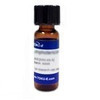Seselin is a pyranocoumarin isolated from the fruits of Seseli indicum by Spath and colleagues in 1939. Seselin was
subsequently isolated from a number of fruits of diverse species, most notably star anise. More recently, Seselin has been
isolated efficiently from the Australian native fuchsia, Correa reflexa, by pressurised hot water extraction. Seselin plays an important role in the regulation of root growth. Seselin inhibits radicle growth in seedlings and antagonises gibberellic acid-induced release of reducing sugars from barley endosperm. Seselin also inhibits the development of blow fly larvae and is anti-inflammatory, cytotoxic, antifungal and spasmolytic.
| Molecular Formula | C14H12O3 |
| References |
Bianca JD et al (2017) Pressurized hot water extraction as a viable bioprospecting tool: Isolation of coumarin natural products from previously unexamined Correa (Rutaceae) species. Chem. Select 2:2439 Barnes CS and Occolowitz JL (1964) The mass spectra of some naturally occurring oxygen heterocycles and related compounds. Aust. J. Chem. 17:975 Kirsch G et al (2016) Natural and synthetic coumarins with effects on inflammation. G. Kirsch et al., Molecules 21:1322 Mukandiwa L. et al (2013) Isolation of Seselin from Clausena anisata (Rutaceae) leaves and its effects on the feeding and development of Lucilia cuprina larvae may explain its use in ethnoveterinary medicine. J. Ethnopharmacol. 2013, 150, 886. Raphael G and Eliahu T (1971) Effects of Seselin and coumarin on growth, indoleacetic acid oxidase, and peroxidase, with special reference to cucumber (Cucumis sativa L.) radicles. Plant Physiol. 47:312 |


